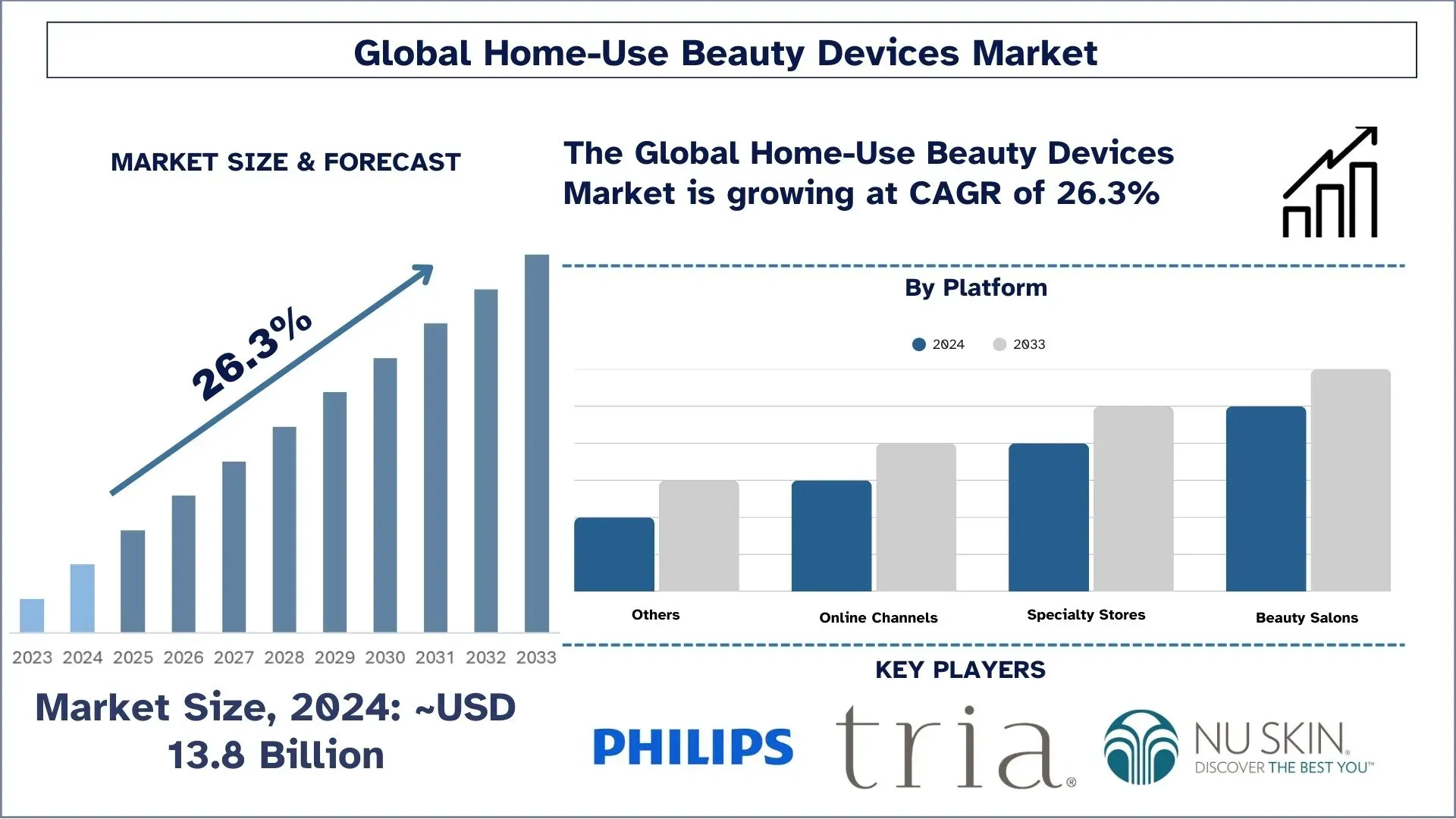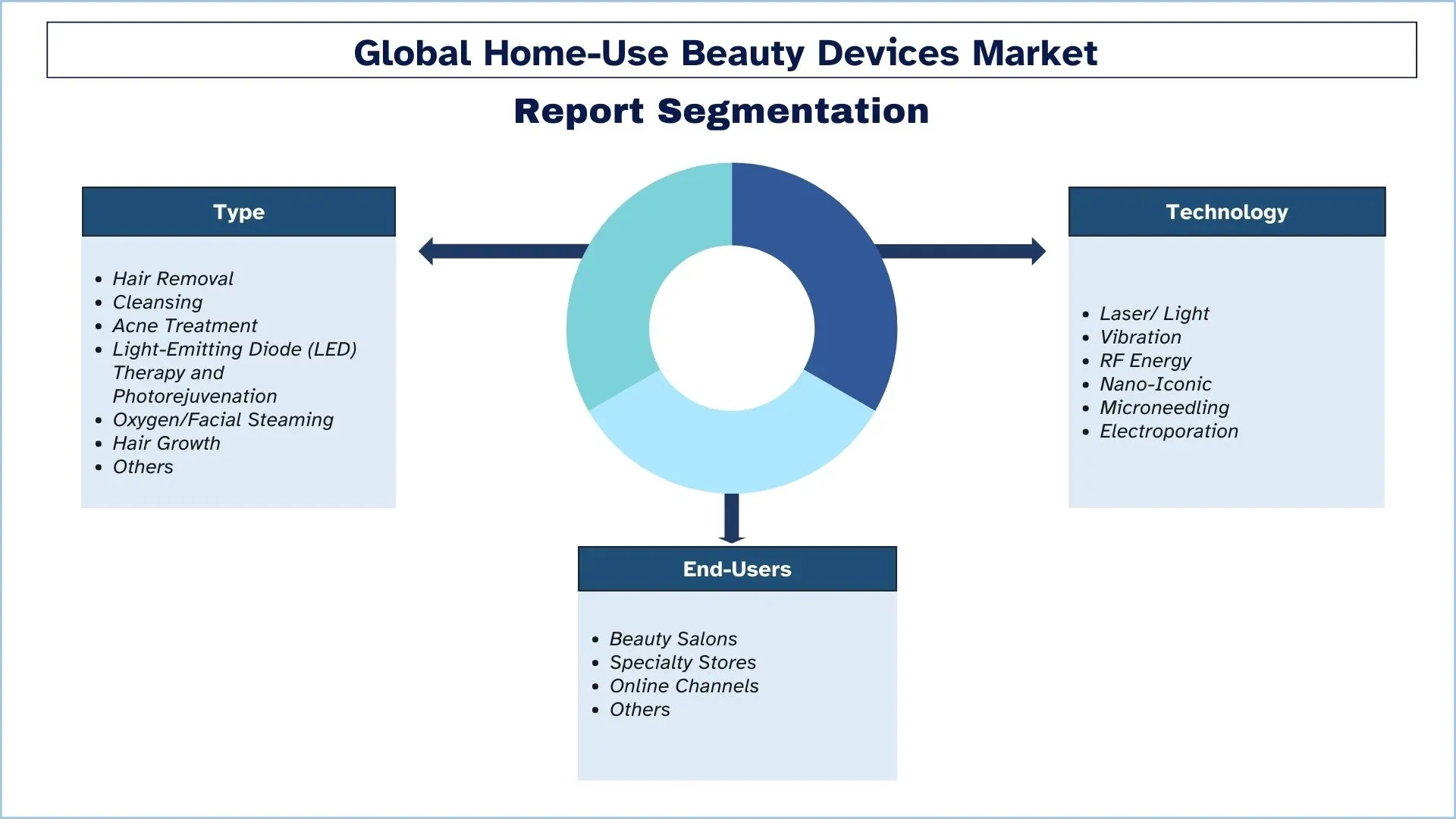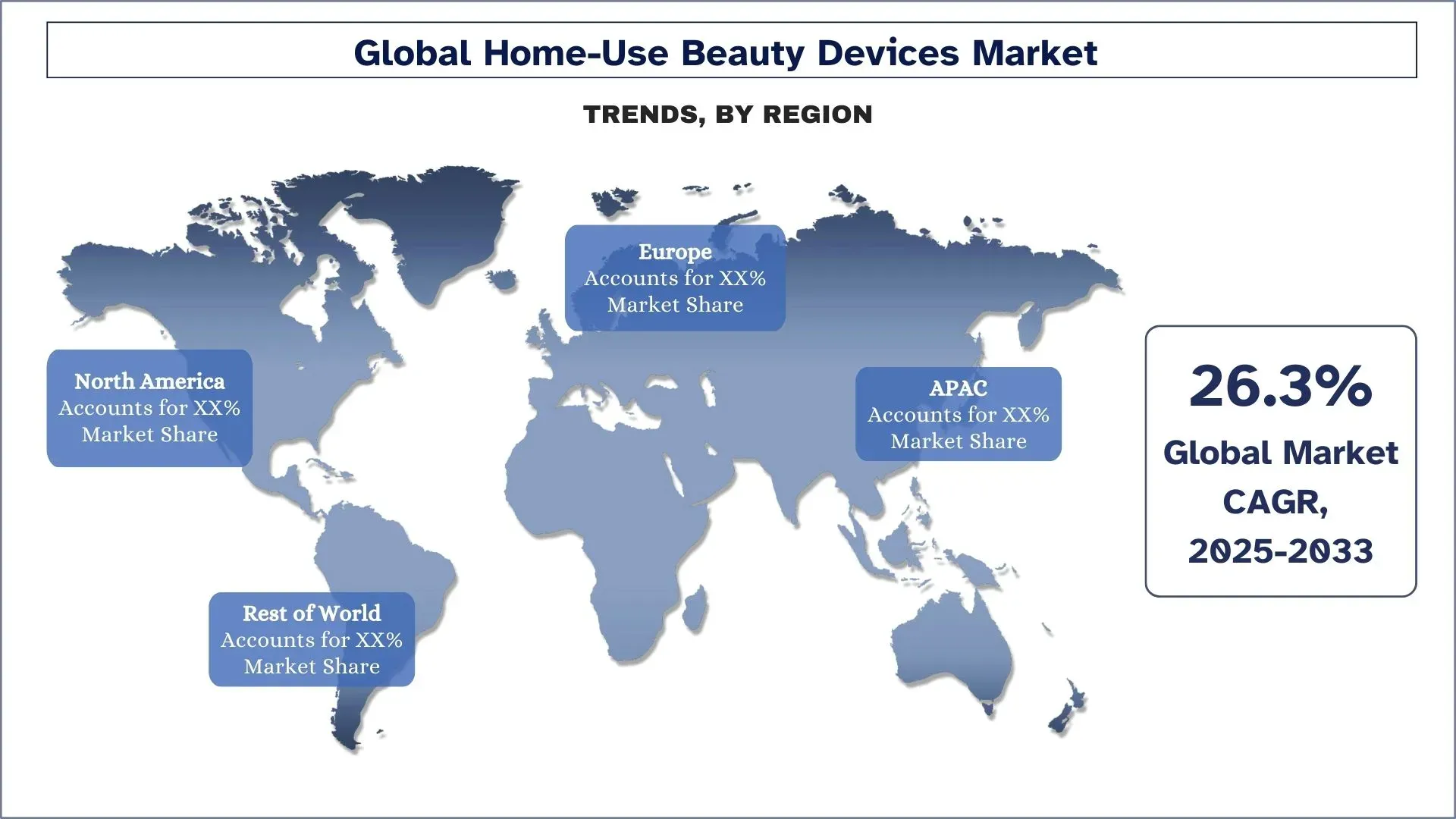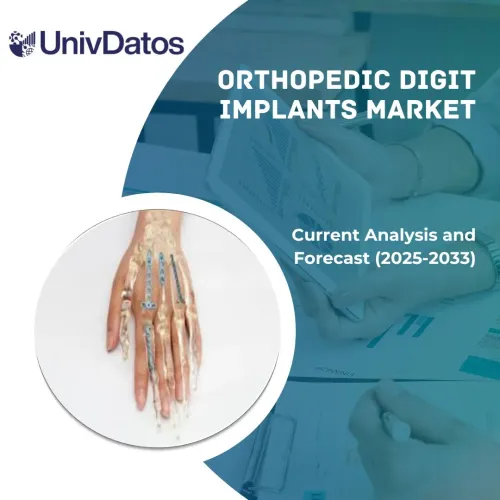- Home
- About Us
- Industry
- Services
- Reading
- Contact Us
Home-Use Beauty Devices Market: Current Analysis and Forecast (2025-2033)
Emphasis on Type (Hair Removal, Cleansing, Acne Treatment, Light-Emitting Diode (Led) Therapy and Photorejuvenation, Oxygen/Facial Steaming, Hair Growth, Others); Technology (Laser/ Light, Vibration, Rf Energy, Nano-Iconic, Microneedling, Electroporation); End User (Beauty Salons, Specialty Stores, Online Channels, Others) and Region/Country

Home-Use Beauty Devices Market Size & Forecast
The Home-Use Beauty Devices Market was valued at approximately USD 13.8 billion in 2024 and is expected to grow at a substantial CAGR of around 26.3% during the forecast period (2025-2033), owing to rising consumer focus on at-home self-care & aesthetics.
Home-Use Beauty Devices Market Analysis
The home-use beauty devices market is expected to grow at a strong CAGR of around 25.6% during the forecast period, owing to the growing emphasis on aesthetics and cosmetic dentistry. Moreover, the global home-use beauty devices market is experiencing significant growth due to the increasing geriatric population, skin issues caused by sun rays, and awareness regarding personal hygiene among consumers. For instance, in January 2020, L’Oréal S.A. unveiled an artificial intelligence (AI)-enabled at-home skincare device, named Perso. It is equipped with a patented motorized system that allows it to provide personalized skincare formulas for customers (in the form of moisturizers, serums, and under-eye creams) based on real-time data and trend analysis. The Perso device is operable via Bluetooth and is NFC (Near-field Communication) compliant, which means that it works best in tandem with a smartphone. Thus, with the growing focus on technology and smartphones used by consumers, which gives detailed information across the world.
Home-Use Beauty Devices Market Trends
This section discusses the key market trends influencing the various segments of the Home-Use Beauty Devices market as identified by our research experts.
The Integration of Smart Technologies
The global home-use beauty devices market integrates smart technologies that include artificial intelligence (AI) and Internet of Things (IoT) connectivity as one emerging trend. Devices in the present era provide individualized skincare recommendations because they analyze skin health and recommend personalized treatment plans. The use of smart technology has produced better user results and extensive treatment benefits for customers who need customized home beauty solutions. Market growth and innovative advancements emerge from digitalization trends in personal care because devices now integrate AI and IoT functions to enhance their functionality.
Home-Use Beauty Devices Market Industry Segmentation
This section provides an analysis of the key trends in each segment of the global Home-Use Beauty Devices market report, along with forecasts at the global, regional, and country levels for 2025-2033.
The Hair Removal Market is Expected to Witness a Higher CAGR than the Home-Use Beauty Devices Market.
Based on type, the market is categorized into hair removal, cleansing, acne treatment, light-emitting diode (LED) therapy and photo rejuvenation, oxygen/facial steaming, hair growth, and others. Amongst types, the hair removal category held a significant share of the market in 2024. This is mainly due to improved methods that are quick, painless, and more effective procedures, such as laser hair removal treatment. Over the forthcoming years, the rising popularity of home-use hair removal techniques among the younger generation is likely to boost the demand for hair removal solutions.
The Laser/ Light Segment Holds the Largest Share of the Market.
Based on technology, the market is categorized into laser/ light, vibration, RF energy, nano-iconic, micro-needling, and electroporation. Among these, laser/ light is expected to witness the highest CAGR during the forecast period. This technology boosts the production of fibroblasts, which increases the volume of collagen. This, in due course, makes the skin fresher, younger-looking, and stronger, thereby boosting the overall look. Laser/light targets specific areas of the skin, without harming the healthy skin. The continuous development of new products and procedures is likely to strengthen the market of the segment during the forecast period.

North America has a significant share of the market in 2024.
North America is expected to show significant growth in the home-use beauty devices market. The major contributors to the growth of this market are the US and Canada. The increase in technology development in emerging economies, as well as the expansion of the beauty industry, has contributed to the growth of the North American market. North America has a higher adoption rate of technologically advanced and innovative solutions and devices. Enhanced consumer awareness regarding the availability of various beauty devices and skin treatments has propelled the growth of the market in the region. Hence, these require devices in the region, which drives the demand for home-use beauty device systems in the region. Furthermore, the increasing geriatric population and new product launches, and various developmental strategies adopted by the regional market will drive market growth. The endorsement by Hollywood stars also significantly contributed to the considerable growth of the state in the U.S. beauty devices market. For instance, according to the Skin Cancer Organization, people who use sunscreen with an SPF of 15 or higher daily show 24% less skin age than those who do not use sunscreen daily.
U.S. Dominates the North America Home-Use Beauty Devices Market
The U.S. home-use beauty devices market continues to expand rapidly because of technological developments and rising consumer self-care interest, and they are selecting home-based beauty solutions. The market continues to expand because people have more skin issues while becoming more aware of their appearance, and new beauty device technologies appear. The market shows an upward trend because consumers choose at-home treatments that provide both convenience and cost-effectiveness, and this drives demand for laser hair removal tools and LED therapy masks, and microcurrent facial toning devices. Smart features added to devices through app connectivity, along with AI skin analysis functions, increase user experience by helping customers create customized skincare treatments. The U.S. stands as the premier market according to factors that drive growth in the domestic home-use beauty device industry.

Home-Use Beauty Devices Market Industry Competitive Landscape
The Home-Use Beauty Devices market is competitive, with several global and international players. The key players are adopting different growth strategies to enhance their market presence, such as partnerships, agreements, collaborations, new product launches, geographical expansions, and mergers and acquisitions.
Top Home-Use Beauty Devices Market Companies
Some of the major players operating in the market are Nu Skin Enterprises Inc.; TRIA BEAUTY; Koninklijke Philips N.V.; NuFACE, L’Oréal S.A.; Procter & Gamble, Silkn.com, www.photomedex.com; Candela Corporation; MTG Co., Ltd.
Recent Developments in the Home-Use Beauty Devices Market
September 2023:L'Oréal (France) expanded operations in India to enter the dermocosmetic market. Moreover, the company also launched L'Oreal Dermatological Beauty (LDB) in India, which will bring products to dermatologists, patients, and the company.
Home-Use Beauty Devices Market Report Coverage
Report Attribute | Details |
Base year | 2024 |
Forecast period | 2025-2033 |
Growth momentum | Accelerate at a CAGR of 26.3% |
Market size 2024 | USD 13.8 Billion |
Regional analysis | APAC, Europe, Asia-Pacific, Rest of the World |
Major contributing region | North America is expected to grow at the highest CAGR during the forecasted period. |
Key countries covered | U.S., Canada, Germany, France, UK, Spain, Italy, China, Japan, and India |
Nu Skin Enterprises Inc.; TRIA BEAUTY; Koninklijke Philips N.V.; NuFACE, L’Oréal S.A.; Procter & Gamble, Silkn.com, www.photomedex.com; Candela Corporation; MTG Co., Ltd. . | |
Report Scope | Market Trends, Drivers, and Restraints; Revenue Estimation and Forecast; Segmentation Analysis; Demand and Supply Side Analysis; Competitive Landscape; Company Profiling |
Segments Covered | By Type, By Technology, By End-Users, By Region/Country |
Reasons to Buy the Home-Use Beauty Devices Market Report:
The study includes market sizing and forecasting analysis validated by authenticated key industry experts.
The report presents a quick review of overall industry performance at a glance.
The report covers an in-depth analysis of prominent industry peers with a primary focus on key business financials, product portfolios, expansion strategies, and recent developments.
Detailed examination of drivers, restraints, key trends, and opportunities prevailing in the industry.
The study comprehensively covers the market across different segments.
Deep dive regional-level analysis of the industry.
Customization Options:
The Global Home-Use Beauty Devices Market can be customized further as per the requirements or any other market segment. Besides this, UnivDatos understands that you may have your own business needs; hence, feel free to contact us to get a report that completely suits your requirements.
Table of Content
Research Methodology for Home-Use Beauty Devices Market Analysis (2023-2033)
We analyzed the historical market, estimated the current market, and forecasted the future market of the global Home-Use Beauty Devices Market to assess its application in major regions worldwide. We conducted exhaustive secondary research to gather historical market data and estimate the current market size. To validate these insights, we carefully reviewed numerous findings and assumptions. Additionally, we conducted in-depth primary interviews with industry experts across the Home-Use Beauty Devices Market value chain. After validating market figures through these interviews, we used top-down and bottom-up approaches to forecast the overall market size. We then employed market breakdown and data triangulation methods to estimate and analyze the market size of industry segments and sub-segments.
Market Engineering
We employed data triangulation techniques to finalize the overall market estimation and derive precise statistical numbers for each segment and sub-segment of the global Home-Use Beauty Devices Market. We split the data into several segments and sub-segments by analyzing various parameters and trends, including type, technology, end-users, and regions within the global Home-Use Beauty Devices Market.
The main objective of the Global Home-Use Beauty Devices Market Study
The study identifies current and future trends in the global Home-Use Beauty Devices Market, providing strategic insights for investors. It highlights regional market attractiveness, enabling industry participants to tap into untapped markets and gain a first-mover advantage. Other quantitative goals of the studies include:
Market Size Analysis: Assess the current and forecast market size of the global Home-Use Beauty Devices Market and its segments in terms of value (USD).
Home-Use Beauty Devices Market Segmentation: The study segments the market by type, technology, end-users, and region.
Regulatory Framework & Value Chain Analysis: Examine the regulatory framework, value chain, customer behavior, and competitive landscape of the Home-Use Beauty Devices Market industry.
Regional Analysis: Conduct a detailed regional analysis for key areas such as Asia Pacific, Europe, North America, and the Rest of the World.
Company Profiles & Growth Strategies: Company profiles of the Home-Use Beauty Devices Market and the growth strategies adopted by the market leaders to sustain the fast-growing market.
Frequently Asked Questions FAQs
Q1: What is the Home-Use Beauty Devices market's current size and growth potential?
As of 2024, the global Home-Use Beauty Devices market is valued at approximately USD 13.8 billion and is projected to grow at a CAGR of 26.3% through 2033.
Q2: What are the driving factors for the growth of the Home-Use Beauty Devices market?
Consumers increasingly prioritize skincare and personal wellness, especially post-pandemic. The demand for salon-quality treatments at home, like anti-aging, acne treatment, and hair removal, continues to grow.
Q3: Which market has the largest share of the Home-Use Beauty Devices market by type?
The Hair Removal market dominates the global Home-Use Beauty Devices market by the type segment.
Q4: What are the major trends in the Home-Use Beauty Devices market?
The market is seeing innovation in LED therapy, microcurrent, radiofrequency, and ultrasonic technologies. Devices are becoming safer, more effective, and often app-connected for better user engagement and personalization.
Q5: Which region will dominate the Home-Use Beauty Devices market?
The North America region currently dominates the global Home-Use Beauty Devices Market.
Q6: What are the biggest challenges in the Home-Use Beauty Devices market?
Despite rising demand, many users lack proper knowledge about correct device usage. Misuse can lead to skin damage or ineffective results, and skepticism remains around product efficacy, making education and credibility critical.
Q7: Who are the Top players in the global Home-Use Beauty Devices market?
The leading companies driving innovation in the Home-Use Beauty Devices market include:
• Nu Skin Enterprises Inc.
• TRIA BEAUTY
• Koninklijke Philips N.V.
• NuFACE
• L’Oréal S.A.
• Procter & Gamble
• Silkn.com
• www.photomedex.com
• Candela Corporation
• MTG Co., Ltd.
Q8: What are the key investment opportunities in the home-use beauty devices sector?
The sector offers strong investment potential in areas such as AI-integrated smart beauty devices, multifunctional tools (e.g., combining cleansing, toning, and anti-aging), and emerging markets with growing middle-class populations. Strategic investments in R&D, IP-protected technologies, and direct-to-consumer (DTC) e-commerce platforms are also driving higher margins and market differentiation.
Q9: How can manufacturers and brands address regulatory and compliance challenges in global markets?
To scale globally, companies must navigate diverse regulatory landscapes such as FDA approval in the U.S., CE marking in Europe, and CFDA compliance in China. Investing in regulatory consulting, building region-specific product variants, and maintaining clear clinical efficacy documentation helps accelerate market entry and build consumer trust across regions.
Related Reports
Customers who bought this item also bought










